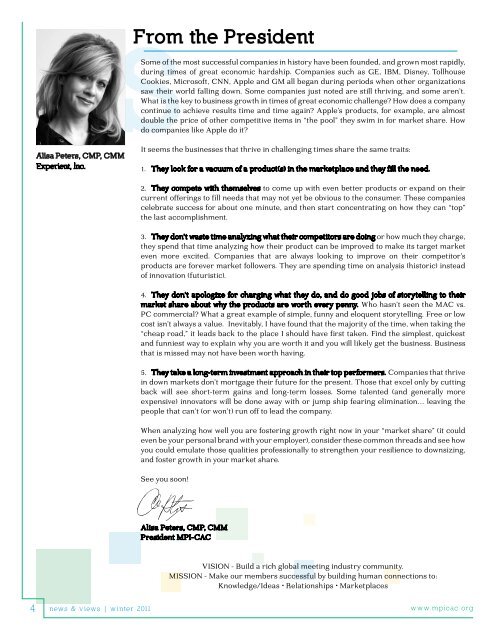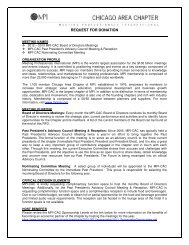electronic format - Meeting Professionals International Chicago Area ...
electronic format - Meeting Professionals International Chicago Area ...
electronic format - Meeting Professionals International Chicago Area ...
You also want an ePaper? Increase the reach of your titles
YUMPU automatically turns print PDFs into web optimized ePapers that Google loves.
From the President<br />
S<br />
Some of the most successful companies in history have been founded, and grown most rapidly,<br />
during times of great economic hardship. Companies such as GE, IBM, Disney, Tollhouse<br />
Cookies, Microsoft, CNN, Apple and GM all began during periods when other organizations<br />
saw their world falling down. Some companies just noted are still thriving, and some aren’t.<br />
What is the key to business growth in times of great economic challenge? How does a company<br />
continue to achieve results time and time again? Apple’s products, for example, are almost<br />
double the price of other competitive items in “the pool” they swim in for market share. How<br />
do companies like Apple do it?<br />
Alisa Peters, CMP, CMM<br />
Experient, Inc.<br />
It seems the businesses that thrive in challenging times share the same traits:<br />
1. They look for a vacuum of a product(s) in the marketplace and they fill the need.<br />
2. They compete with themselves to come up with even better products or expand on their<br />
current offerings to fill needs that may not yet be obvious to the consumer. These companies<br />
celebrate success for about one minute, and then start concentrating on how they can “top”<br />
the last accomplishment.<br />
3. They don’t waste time analyzing what their competitors are doing or how much they charge,<br />
they spend that time analyzing how their product can be improved to make its target market<br />
even more excited. Companies that are always looking to improve on their competitor’s<br />
products are forever market followers. They are spending time on analysis (historic) instead<br />
of innovation (futuristic).<br />
4. They don’t apologize for charging what they do, and do good jobs of storytelling to their<br />
market share about why the products are worth every penny. Who hasn’t seen the MAC vs.<br />
PC commercial? What a great example of simple, funny and eloquent storytelling. Free or low<br />
cost isn’t always a value. Inevitably, I have found that the majority of the time, when taking the<br />
“cheap road,” it leads back to the place I should have first taken. Find the simplest, quickest<br />
and funniest way to explain why you are worth it and you will likely get the business. Business<br />
that is missed may not have been worth having.<br />
5. They take a long-term investment approach in their top performers. Companies that thrive<br />
in down markets don’t mortgage their future for the present. Those that excel only by cutting<br />
back will see short-term gains and long-term losses. Some talented (and generally more<br />
expensive) innovators will be done away with or jump ship fearing elimination… leaving the<br />
people that can’t (or won’t) run off to lead the company.<br />
When analyzing how well you are fostering growth right now in your “market share” (it could<br />
even be your personal brand with your employer), consider these common threads and see how<br />
you could emulate those qualities professionally to strengthen your resilience to downsizing,<br />
and foster growth in your market share.<br />
See you soon!<br />
Alisa Peters, CMP, CMM<br />
President MPI-CAC<br />
VISION - Build a rich global meeting industry community.<br />
MISSION - Make our members successful by building human connections to:<br />
Knowledge/Ideas • Relationships • Marketplaces<br />
4 news & views | winter 2011 www.mpicac.org
















